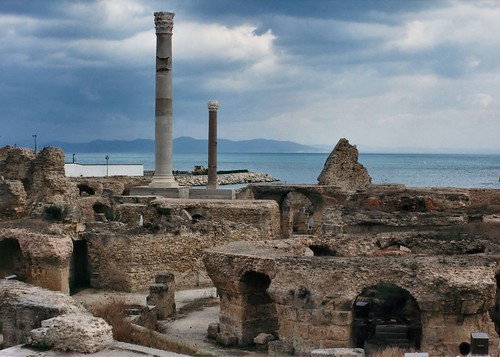
Places with History: Carthage, in Tunisia
Today we offer another trip through history, this time to find out which one of the greatest civilizations in human history and became the major economic power in the Mediterranean. It was founded by the Phoenicians in the thirteenth century BC under the name qart Haddast, a city that hardly began with an area of 50 km2, and over the centuries came to be a metropolitan area to 30,000 km2. The Carthaginian Empire was spread throughout the Mediterranean, with bases across northern Africa to Spain and across Ibiza and Sicily.

However, like all great empires, it also came to an end and had to bow to another couple who rule soon ended up as the Empire would be the largest in history: the Roman. It was in the year 146 a.C. when the Carthaginian Empire fell defeated before the Roman Empire and its capital, Carthage was destroyed.
The story did not end there for this Mediterranean enclave, since the Romans built their ruins Julia Carthage that became the second largest city in the whole empire is that its central location within the Mediterranean Sea made it an ideal location in the economy and the military defense of the area. Thus, for centuries, has been so desired and pursued. While later, Vandals and Byzantines took their domain. They occupied the capital until 705 when the Muslims took it again but not before completely destroying and massacring its inhabitants.
The historical episodes of this city went through the battles occurred during the Eighth Crusade, who died in the French King Louis IX in the year 1270, with the conquest by the pirate Barbarossa, or invasion of the Spanish troops of Charles V . Having been under the yoke of the Ottoman Empire and even under the power of the French troops of Napoleon and Hitler of Germany.
Now, so much history in their stones, they have earned to be declared as a World Heritage Site by Unesco in 1979 and could not be less, we have brought wealth from those empires that once were masters of their land.
The heat is suffocating and visit some other ruins and one has to walk a lot, sometimes by wide avenues with no trees or anything where shelter. You can visit the National Museum of Carthage whose entry you can visit the ruins of all these. Admissions are a Tunisian Dinar and also want a picture you have to pay separately. But the best thing is that there will provide maps and will recommend the best route possible. But it aims to go early if you want to avoid crowds.
The main views you can do in Carthage are:
• Temple Tophet, of Phoenician origin
• Punic ports, an entry in the center of the sea is an island
• Quartier Magon, precincts where there are ruins of Roman houses
• Hot Antonino, visit the most important of these ruins of Carthage, one of the best preserved.
• Adriano theater, which has been rebuilt and is now used for concerts
• The Roman villas: the best preserved. A Roman road leads you among them, there are statues, mosaics and above all, a breathtaking view of the port of Carthage.
• amphitheater des Martrys
• Roman circus

As with any of these sites of historic ruins, the charm lies rather in the imagination, to be able to see and intuit how they lived in those times, to find pieces and corners with a special detail, and know enough of history there happened.
Traveling to Tunisia
Journey between the sea and the desert
Tunisia the desert country of mirages
Leave a Reply
You must be logged in to post a comment.
Recent Comments